|
|
|
Sort Order |
|
|
|
Items / Page
|
|
|
|
|
|
|
| Srl | Item |
| 1 |
ID:
163389
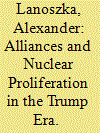

|
|
|
|
|
| Summary/Abstract |
Donald Trump appears to have intensified the danger of U.S. allies wanting their own nuclear weapons, but such concerns are exaggerated. U.S. alliances are more resilient than commonly presumed with actual force deployments, which don’t appear to be changing any time soon, mattering more than rhetoric to make security guarantees adequate for the foreseeable future.
|
|
|
|
|
|
|
|
|
|
|
|
|
|
|
|
| 2 |
ID:
148972
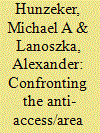

|
|
|
|
|
| Summary/Abstract |
The Baltic States are once again worried that their security is under threat. The US and NATO have responded with air patrols, joint exercises, and battalion-sized ground-force deployments. As important as these efforts have been, they do not fully address Russia’s anti-access/area denial (A2/AD) and precision strike capabilities, both of which undermine NATO’s stratagem for deterring aggression in the first place. Alexander Lanoszka and Michael A Hunzeker assess the current military imbalance and describe two conflict scenarios to show how A2/AD and precision weapons threaten extended deterrence. They conclude with a discussion of the policy implications.
|
|
|
|
|
|
|
|
|
|
|
|
|
|
|
|
| 3 |
ID:
165333
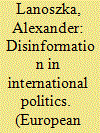

|
|
|
|
|
| Summary/Abstract |
Concerns over disinformation have intensified in recent years. Policymakers, pundits, and observers worry that countries like Russia are spreading false narratives and disseminating rumours in order to shape international opinion and, by extension, government policies to their liking. Despite the importance of this topic, mainstream theories in International Relations offer contradictory guidance on how to think about disinformation. I argue that disinformation is ineffective in terms of changing the policies of a target as regards to its foreign policy alignments and armaments – that is, the balance of power. To be strategically effective, disinformation must somehow overcome three powerful obstacles: first, the fundamental uncertainty that international anarchy generates over any information broadcasted by adversaries; second, the pre-existing prejudices of foreign policy elites and ordinary citizens; and third, the countermeasures that are available even amid political polarisation. I examine the most likely case of there seemingly being a conscious and effective strategy that emphasises disinformation: the Russian campaign that has targeted the Baltic states, especially since the 2014 annexation of Crimea. The available evidence strongly suggests that the strategic effects of disinformation are exaggerated.
|
|
|
|
|
|
|
|
|
|
|
|
|
|
|
|
| 4 |
ID:
171791
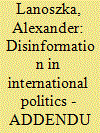

|
|
|
| 5 |
ID:
157681
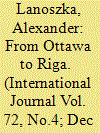

|
|
|
|
|
| Summary/Abstract |
In June 2016, Canada joined the United States, Great Britain, and Germany in becoming a Framework Nation that leads a multinational battalion-sized battlegroup in Latvia. Canada thus appears to be reprising the role it played during the Cold War as a leading participant in North Atlantic Treaty Organization deterrence and reassurance initiatives in Europe. Yet the three tensions that made Canada reduce its military commitments to allies over the course of the Cold War might resurface in the Baltic region. These three tensions relate to conventional specialization amid alliance nuclearization, low defence spending despite that specialization, and the potential decoupling of Canadian security interests from those of its European partners. Canada might find itself lacking the willingness and ability to sustain the tasks attending the Latvia deployment if the threat environment intensifies.
|
|
|
|
|
|
|
|
|
|
|
|
|
|
|
|
| 6 |
ID:
152378
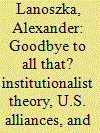

|
|
|
|
|
| Summary/Abstract |
In an important and stimulating article, Stephan Frühling and Andrew O’Neil argue in favor of applying institutionalist theory to understand the alliance politics of U.S. nuclear weapons strategy. But what promise does institutionalist theory really hold in thinking about highly unequal alliances nested in their particular threat environments? I argue that much work remains to be done to determine how much better institutionalist variables explain intra-alliance dynamics over alternative arguments that emphasize power and interests. Balances of power and the nature of threat environments may already account for key aspects of extended deterrent relationships supported by the United States in Europe and Asia. Ironically, the implication of this more traditional interpretation of alliances is that more continuity than change will characterize how Donald Trump will manage U.S. security relationships as President.
|
|
|
|
|
|
|
|
|
|
|
|
|
|
|
|
| 7 |
ID:
177887
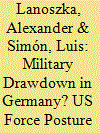

|
|
|
|
|
| Summary/Abstract |
The Biden administration has promised to revitalize a transatlantic alliance that has experienced much strain during Donald Trump’s presidency. Trump’s focus on strategic competition with China, equivocal attitude toward Russia, repeated criticisms of NATO and Germany, and insistence that Europeans pay for their own defense have raised questions about the future of US defense strategy in Europe. Nevertheless, his administration in fact committed additional money and troops to deterring Russia from threatening US allies.1 Amid such confusing signals, one of Trump’s last acts that roiled transatlantic relations was to announce in July 2020 a plan to reduce military personnel stationed in Germany from about 34,500 to 25,000, return some portion of these troops to the United States, regroup some air and command assets in Italy and Belgium, and reinforce the US military’s rotational presence in Poland and the Black Sea region. The announcement of these measures stunned European allies, who had not been previously consulted.
|
|
|
|
|
|
|
|
|
|
|
|
|
|
|
|
| 8 |
ID:
177992
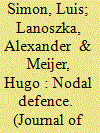

|
|
|
|
|
| Summary/Abstract |
Scholars and pundits alike continue to portray the U.S.-led regional alliance systems in Europe and East Asia in stark, dichotomous terms. Whereas the North Atlantic Treaty Organization is the standard model of multilateralism, the U.S.-led system of bilateral alliances in East Asia is the archetypal ‘hub-and-spokes’ structure in which different allies (the spokes) enjoy deep bilateral strategic ties with Washington (the hub) but not with each other. We argue that these common depictions of U.S.-led alliance systems are obsolete. Instead, we show that what we label ‘nodal defence’ – a hybrid category that combines overlapping bilateral, minilateral and multilateral initiatives – better captures how the U.S.-led alliance systems in Europe and East Asia operate today. Specifically, nodal defence is a hybrid alliance system in which allies are connected through variable geometries of defence cooperation that are organized around specific functional roles so as to tackle different threats. To show how nodal defence is an emerging central feature of the U.S.-led regional alliance systems, we conduct an original cross-regional comparison of how these alliance systems work, drawing on elite interviews, official documents, and secondary literature.
|
|
|
|
|
|
|
|
|
|
|
|
|
|
|
|
| 9 |
ID:
157826
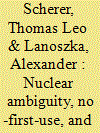

|
|
|
|
|
| Summary/Abstract |
The United States has long embraced calculated ambiguity over the conditions under which it might use nuclear weapons against adversaries, a trend that President Donald J. Trump has continued. This ambiguity could unsettle some observers, especially those who believe that the United States should declare a no-first-use (NFU) policy such that it would not be the first state to introduce nuclear weapons in either a crisis or an armed conflict. NFU advocates identify three potential pathways whereby a more ambiguous posture can lead to increased danger: downward spiral, accidental war, and use-it-or-lose-it. For evidence, they invoke Saddam Hussein’s risk-accepting decision to pre-delegate chemical-weapons use following US nuclear threats in the 1991 Gulf War. In analyzing the reasoning and evidence of these arguments, we argue that the alleged benefits of NFU may be overstated, at least for crisis stability in asymmetric crises, defined by one side’s overwhelming conventional military superiority. Each of the three foregoing pathways is logically inconsistent and the empirical case is misinterpreted. Nuclear ambiguity may not be so dangerous as NFU advocates claim.
|
|
|
|
|
|
|
|
|
|
|
|
|
|
|
|
| 10 |
ID:
158995
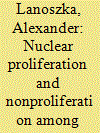

|
|
|
|
|
| Summary/Abstract |
Most alliance-related explanations of nuclear proliferation and nonproliferation draw from US security relationships. Yet, the Soviet Union, too, exhibited variation in proliferation tendencies within its own system of alliances. Only one Warsaw Pact member—Romania—was interested in seeking nuclear weapons, whereas both of its East Asian allies—China and North Korea—pursued nuclear weapons. What explains this pattern of nuclear proliferation and nonproliferation among Soviet allies? I draw on deterrence theory to argue that the same logic that some scholars invoke to explain nuclear proliferation and nonproliferation among US allies can also shed light on patterns of proliferation and nonproliferation among Soviet allies; the quality of Soviet security guarantees varied across recipients in East Central Europe and East Asia, and this variation accounts for subsequent differences in levels of nuclear interest shown by Soviet allies. My claims challenge accounts that the United States and Soviet Union colluded to manage proliferation risks, as well as arguments that democratic states have unique advantages in making credible security guarantees.
|
|
|
|
|
|
|
|
|
|
|
|
|
|
|
|
| 11 |
ID:
143743
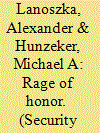

|
|
|
|
|
| Summary/Abstract |
Why the First World War ended in 1918 and not earlier remains a major puzzle. We propose a new theory that emphasizes how honor prolongs wars beyond what rationalist theories can explain. It argues that when honor is insulted, an affronted actor will strive to punish the offender. Absent an apology, the pursuit of a satisfactory punishment leads the affronted belligerent to ignore unfavorable battlefield information, hold logically irreconcilable beliefs, process information in emotional terms, and obsess over status. We predict that wars of prevention and territorial occupation are most likely to elicit honor considerations. We test our argument against an obscure episode in the war where Germany and the United States made peace overtures in December 1916. We demonstrate that honor concerns made Entente decision makers see German aggression as an affront to their honor that only the destruction of Germany's political regime could redress.
|
|
|
|
|
|
|
|
|
|
|
|
|
|
|
|
| 12 |
ID:
145271
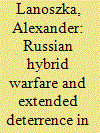

|
|
|
|
|
| Summary/Abstract |
Russia's use of force against Ukraine since early 2014 has prompted some observers to remark that it is engaging in ‘hybrid warfare’. This form of military statecraft has made other former Soviet republics, such as the Baltic countries, fear that Russia would use subversion rather than pursue a conventional military engagement against them. Despite this concern about Russian hybrid war, existing descriptions of this form of war suffer from conceptual weaknesses. In this article hybrid warfare is conceived as a strategy that marries conventional deterrence and insurgency tactics. That is, the belligerent uses insurgent tactics against its target while using its conventional military power to deter a strong military response. The article then outlines why some former Soviet republics are susceptible to Russian hybrid warfare, allowing it to postulate inductively the conditions under which hybrid warfare might be used in general. The analysis yields two policy implications. First, military solutions are not wholly appropriate against hybrid warfare since it exploits latent ethnic grievances and weak civil societies. Second, only under narrow circumstances would belligerents resort to hybrid warfare. Belligerents need to be revisionist and militarily stronger than their targets, but they also need to have ethnic or linguistic ties with the target society to leverage in waging hybrid warfare.
|
|
|
|
|
|
|
|
|
|
|
|
|
|
|
|
| 13 |
ID:
159149
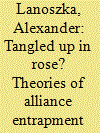

|
|
|
|
|
| Summary/Abstract |
Recent tensions between Russia and the United States have sparked debate over the value of the North Atlantic Treaty Organization (NATO). One controversy surrounds the extent to which NATO raises the risk of war through entrapment—a concept that scholars invoke to describe how states might drag their allies into undesirable military conflicts. Yet scholars have advanced different, even conflicting arguments about how entrapment risks arise. I offer a typology that distinguishes between the mechanisms through which entrapment risks allegedly emerge on the basis of their institutional, systemic, reputational, and transnational ideological sources. I use the 2008 Russo-Georgian War to illustrate how the purported mechanisms of entrapment fare in elucidating that conflict. In analyzing why entrapment risks emerge, and thinking counterfactually about The 2008 War, I argue that scholars need to disentangle the various mechanisms that drive both alliance formation and war to make sure that entrapment risks do indeed exist.
|
|
|
|
|
|
|
|
|
|
|
|
|
|
|
|
| 14 |
ID:
149253
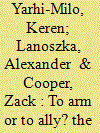

|
|
|
|
|
| Summary/Abstract |
How do great powers decide whether to provide arms to or form alliances with client states? This “patron's dilemma” revolves around a decision about how to best provide security to clients without becoming entrapped in unwanted conflicts. Strong commitments worsen the risk of entrapment, whereas weak commitments intensify fears of abandonment. This traditional alliance dilemma can be addressed through the provision of arms and alliances. Great power patrons primarily make such decisions on the basis of two factors: first, the extent to which the patron believes it and its client have common security interests; and second, whether the patron believes that its client has sufficient military capabilities to deter its main adversary without the patron's assistance. Patrons assess the degree of shared threat and the local balances of capabilities in determining whether to support their clients with arms, alliances, or both. As demonstrated in the U.S. provision of security goods to Taiwan and Israel during the Cold War, this strategic logic explains how great powers manage the patron's dilemma.
|
|
|
|
|
|
|
|
|
|
|
|
|
|
|
|
|
|
|
|
|